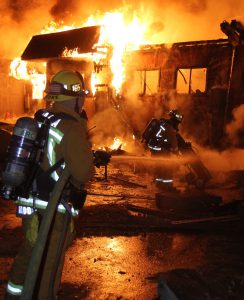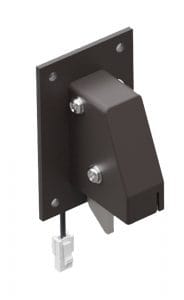Stackright

Automatic shutter actuators make portable buildings fire-safe
Due to their location, especially if positioned close to a building undergoing renovation or construction, portable accommodation units used on construction sites are sometimes required to be ‘Fire Rated’. An industry-leading portable accommodation manufacturer, Stackright Ltd, has partnered with special-purpose electromagnetic mechanisms specialist Magnet Schultz Ltd to develop a technology solution for Fire Rated Accommodation units. These must satisfy the directives detailed in the ‘Fire Prevention on Construction Sites: The Joint Code of Practice on the Protection from Fire of Construction Sites and Buildings Undergoing Renovation.
Skelmersdale-based Stackright Ltd is one of the portable buildings sector’s leading suppliers. The company produces a wide range of portable accommodation units. Product manager Ian Ashworth knows the territory well. He’s been with Stackright for two years, but was active in the plant hire industry for more than a decade before that, specialising in portable accommodation. “The other side of the fence,” as he calls it, pointing out that his former company was the customer, purchasing temporary buildings from the manufacturers in order to hire them out.
 In his product management role at Stackright, Ashworth is responsible for continuing the development of the newest fire containment system on the market. The objective, he explains quite simply, is to enter a segment of the market with portable accommodation units that deliver a level of safety and security unmatched by anything currently available.
In his product management role at Stackright, Ashworth is responsible for continuing the development of the newest fire containment system on the market. The objective, he explains quite simply, is to enter a segment of the market with portable accommodation units that deliver a level of safety and security unmatched by anything currently available.
Stackright builds various types of units to a high specification. For instance, vandal-proof units built using special profiles. It also manufactures bespoke units to detailed and comprehensive specifications; the new fire-rated product in a flat-sided profile style is one such example. For some design elements of custom projects, Stackright looks to expert companies for support. This is the philosophy behind the company’s collaboration with solenoid and electromagnetic actuator specialist Magnet Schultz Ltd (MSL) to design and add bespoke fire-safe technology solutions to its newest product.
Ashworth cites documents produced by the Fire Protection Association. It includes a joint code of practice on protection from fire on construction sites and where buildings are undergoing renovation. He explains a typical scenario where contractors on-site are housed in temporary accommodation units, and that these are often positioned up against the building undergoing renovation. “The danger is real, so the need for fire containment is real too,” says Ashworth. “It’s about preventing a fire from within the cabins spreading to the building under construction or renovation. Fires originating from contracting equipment that go on to damage or destroy historic buildings are not common, but do happen – and they always make the news,” he states.
A few months down the line, Stackright did indeed contact MSL to investigate a bespoke latch design. During the resulting development process, it became clear that other parts of a shutter release system also needed to be developed if the project was to result in a workable, robust solution. Among the elements required was a spring-loaded shutter closer, a system control panel and the wiring harnesses to connect everything up.
 Ashworth is pleased with the system: “it’s a fine example of the benefits of focusing on your own expertise and partnering with a specialist to come up with something world-beating. By blending the expertise of two businesses, Stackright has arrived at a system that uses an industry-recognised shutter system for windows that is virtually maintenance free. It’s a win-win outcome.” Newton is equally pleased with the success of another partnership that is the core of Magnet Schultz’s business collaboration model: “we are a ‘by your side’ partner ready to support our customers’ product developments as regulations, technical requirements and even aspirations develop.”
Ashworth is pleased with the system: “it’s a fine example of the benefits of focusing on your own expertise and partnering with a specialist to come up with something world-beating. By blending the expertise of two businesses, Stackright has arrived at a system that uses an industry-recognised shutter system for windows that is virtually maintenance free. It’s a win-win outcome.” Newton is equally pleased with the success of another partnership that is the core of Magnet Schultz’s business collaboration model: “we are a ‘by your side’ partner ready to support our customers’ product developments as regulations, technical requirements and even aspirations develop.”
The new Stackright buildings are tested for fire containment to 30 minutes, enough time to take action as the design spec demanded. As well as automatic activation from fire and smoke detection sensors, thanks to its electronic system a building complex can be rapidly locked down manually by hitting an emergency button – a function that is also used to test the system daily. “In addition to preventing the fire escaping from a cabin through the windows, the containment system prevents the spread between buildings in the linked and stacked complex – some of which comprise multiple quantities of units. So a fire, whether originating from a careless act or other cause, can be contained within one or two cabins,” Ashworth explains.
